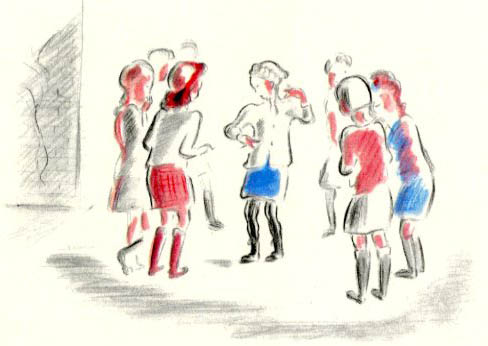
The Hundred Dresses
by Eleanor Estes
Illustraions by Louis Slobodkin
Newbery Honor Medal, 1945
Long before the topic of the day was bullying, and before people held symposiums on dealing with bullying, Eleanor Estes wrote The Hundred Dresses. Written almost 70 years ago, the story and message feels so pertinent today.
This story packs quite a punch, and opens the door for good discussions on teasing, bullying, cowardice, and the role of a bystander. This book is quite short, shorter than a chapter book and longer than a picture book. It is a definite classic that explores the mistakes of childhood, consequences of actions, and the power of apology and forgiveness.
The story is told from the perspective of two friends, Maddie and Peggy, who tease and mock a Polish-immigrant girl in their class, Wanda Petronski. They tease Wanda for her "funny" name, and because she is poor and wears the same faded blue dress to school each day. Peggy is the popular pretty girl, and Maddie her best friend. However Maddie too is poor, and feels very conflicted because she understands Wanda's plight. Maddie doesn't want Peggy to turn her teasing onto her, so she falls right in alongside Peggy.

Yes, that was the way it had all began, the game of the hundred dresses.
It all happened so suddenly and unexpectedly,
with everybody falling right in,
that even if you felt uncomfortable as Maddie had
there wasn’t anything
you could do about it.
Maddie wagged her head up and down.
Yes, she repeated to herself, that was the way it began,
that day, that bright blue day.
It all happened so suddenly and unexpectedly,
with everybody falling right in,
that even if you felt uncomfortable as Maddie had
there wasn’t anything
you could do about it.
Maddie wagged her head up and down.
Yes, she repeated to herself, that was the way it began,
that day, that bright blue day.
One day Wanda tells the girls that she has one hundred dressed in her closet, the obvious and absurd lie becomes a teasing game with the classmates. Led by Peggy, they demand she tell them every detail about each of the one-hundred dresses. She is teased and mocked, and her fatehr decides she must leave that school.
After a school art contest, Wanda Petronski makes the winning submission of the one hundred dresses she had illustrated. Each dress is complete with all of the details she described to her classmates as they bullied her. Peggy and Maddie recognize their error and feel remorse and wish to apologize, but Wanda Petronski moves before they are given the chance.
At last Maddie sat up in bed and pressed her forehead tight in her hands and really thought. This was the hardest thinking she had ever done. After a long, long time she reached an important conclusion. She was never going to stand by and say nothing again. If she ever heard anybody picking on someone because they were funny looking or because they had strange names, she'd speak up. Even if it meant losing Peggy's friendship.The story doesn't end neat and tidy. It leaves you with more of the sickly tummy feeling, of painful regret and resolution to do better. It is a wonderful story of children developing compassion. It opens the door to really discuss many issues, yet doesn't broach preachy and overbearing. Sometimes messages best figured out subtlely are the messages that leave the most lasting impression.

No comments:
Post a Comment